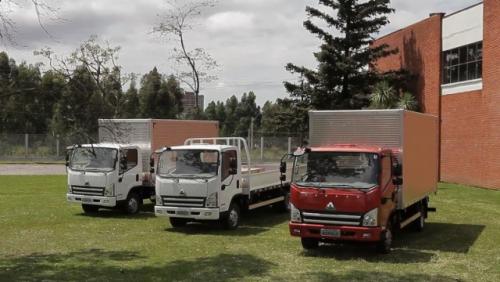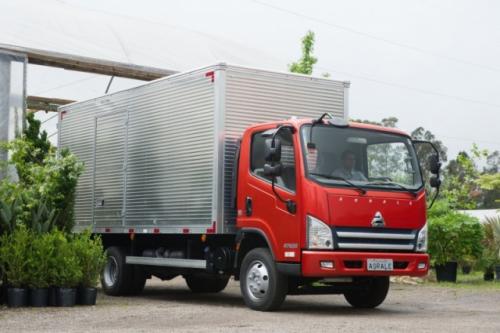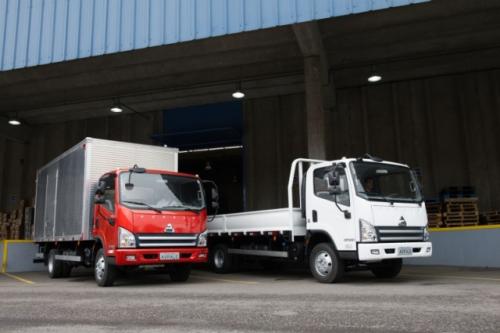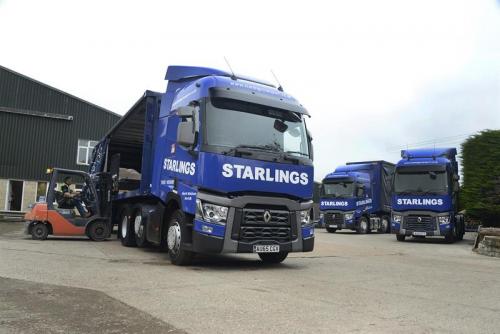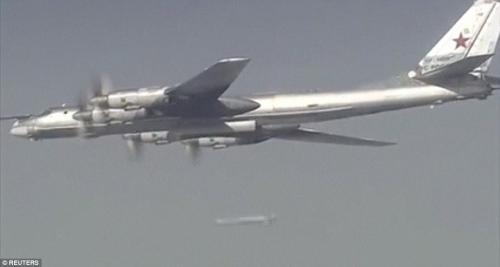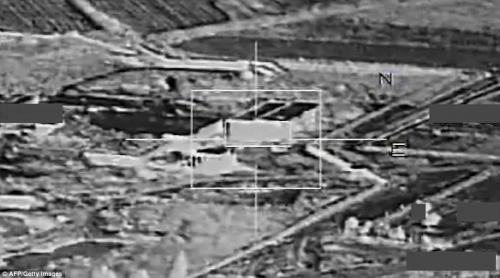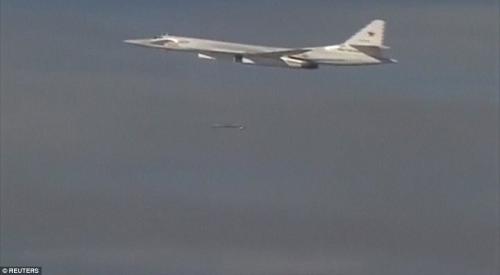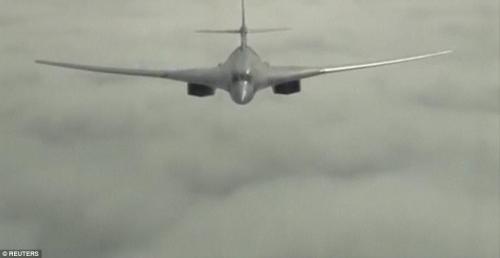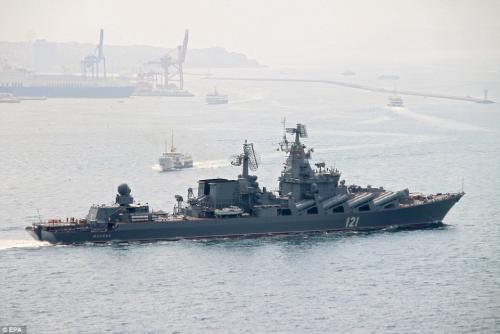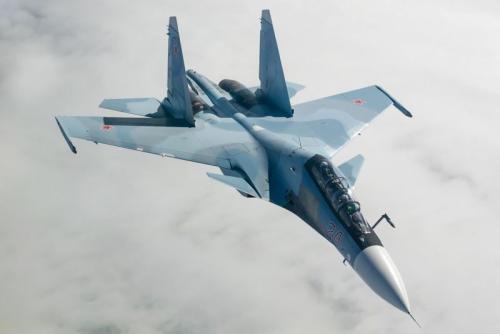
kscarbel2
Moderator-
Posts
18,550 -
Joined
-
Days Won
112
Content Type
Profiles
Forums
Gallery
Events
Blogs
BMT Wiki
Collections
Store
Everything posted by kscarbel2
-
Pierce manufacturing recalling 910 fire trucks
kscarbel2 replied to kscarbel2's topic in Trucking News
Oshkosh has one of the most arrogant company cultures in America, up there with Caterpillar and Allison. (The folks at Ferrara are good people) -
-
-
Vlad, correct me if I'm wrong. My understanding is the Russian Air Force has been severely underfunded since the fall of the Soviet Union (although its gotten some funding in recent years). This must be the first major overseas combat deployment in decades. That the Russian military aircraft industry, as the least funded of the major world powers (since the fall of the Soviet Union), can create combat aircraft as good as it does with modest resources, is testimony to the excellence of its engineering teams. Not only that, it’s damning to the western aircraft makers. The Russian Air Force in Syria....."Going Downtown"
-
You pretty much hit the nail on the head. I will say though that the Kurds are a double-edged sword. Turkey as well.......at times a good ally, but unhelpful when ISIS was forming. It's an extremely complicated issue, but one the Middle East needs to work out on its own. We can't "make" the Middle East change, rather it has to want to change, and do it on its own. As non-Muslim western outsiders, they're not going to listen to us. For decades, to each degree we tried to force change, elements simultaneously resisted. Thus I say, only when the Middle East (Arab League) countries realize the necessity to help themselves and change, will peace blossom in the region.
-
Transport Brazil / November 5, 2016 Brazilian truck, off-road utility vehicle and farm tractor manufacturer Agrale (http://www.agrale.com.br/en) has launched an all-new light truck range for year 2016. The new models are designated A7500, A8700 and A10000, and feature a spacious new cab as well as a long list of standard features. Key specifications for the trucks are 3.8-liter Cummins ISF in-line four cylinder engines rated at 152 and 162 horsepower with SCR after-treatment system, electronic common rail injection system; Eaton transmissionsm, front and rear Dana axles (A8700 and A10000), Dana air brakes and ABS. Agrale A7500 152 horsepower Cummins ISF 3.8 with 443 Nm of torque Eaton FSO 4505C manual 5-speed overdrive 3,860mm wheelbase 4,560 kg GVW. Agrale A8700 162 horsepower Cummins ISF 3.8 with 600 Nm of torque Eaton FSO 4505C manual 5-speed overdrive 3,500mm or 4,200mm wheelbase 5,630kg or 5,590 kg GVW. Agrale A10000 162 horsepower Cummins ISF 3.8 with 600 Nm of torque Eaton FSO 4505C manual 5-speed overdrive 3,750mm or 4,350mm wheelbase 6,695kg or 6,590kg GVW. .
-
Associated Press / November 18, 2015 Oshkosh subsidiary Pierce Manufacturing is recalling 910 fire trucks because the wheels could come loose while being driven. The recall covers the Arrow XT, Dash, Enforcer, Lance and Quantum models from the 2006 and 2007 model years. Boots that cover the ball joints can rip and cause the joints to fail, increasing the risk of a crash. The recall comes after the National Highway Traffic Safety Administration began investigating the trucks in March. The agency received a complaint in January from a fire department that a driver had trouble steering a truck and never felt in control. Mechanics found problems in the ball joints, which connect wheels to the steering system. No injuries were reported. Dealers will inspect trucks for torn boots and replace worn ball joints starting Nov. 30. Related reading: http://www.bigmacktrucks.com/index.php?/topic/39143-us-safety-agency-probes-pierce-fire-truck-steering-problems/?hl=pierce http://www.bigmacktrucks.com/index.php?/topic/37610-pierce-fire-trucks-recalled-after-wheel-falls-off-portland-ladder-truck/?hl=pierce http://koin.com/2014/11/03/pierce-recalls-fire-trucks-when-wheel-falls-off/ http://www.abc2news.com/news/region/anne-arundel-county/anne-arundel-county-pulls-fire-apparatus-out-of-service
-
Starlings migrates to Renault Trucks Range T
kscarbel2 replied to kscarbel2's topic in Trucking News
-
Transport Engineer / November 18, 2015 Starlings Transport and Storage says it has selected Renault Trucks’ Range T for trunking work, following head-to-head comparisons against other OEMs’ tractors looking at fuel consumption and driver acceptance. The Norfolk-based pallet freight distributor has added three 44-tonne Range T460 tractor units to its 25-strong mixed fleet and, according to director Matt Starling is about to order another two. “We carried out direct comparisons, testing vehicles back-to-back with other brands, and we were impressed by the initial fuel figures from the Range T,” states Starling. “The drivers were also very positive, preferring the Renault Truck’s driveline and commenting on the space in the cab, which has been much improved,” he continues. “We currently have three trucks on the road ... They are running fully-freighted, often at full weight and are performing very well under pressure.” Starlings Transport has run Renault trucks before, reporting good experience with Renault Premiums for Pallet Network local deliveries. “The market is buoyant again, but highly competitive and we needed the best possible trucks offering optimum reliability, a good return on fuel as well as a competitive deal,” explains Starling. “Quite simply, compared to their competitors, BRS and Renault Trucks offered the best package overall.” The latest three Renault Range T tractors were all supplied by Renault Trucks’ dealer Norfolk Truck and Van on three-year contract hire through BRS. .
-
MAN Truck & Bus Press Release / November 18, 2015 MAN Genuine Parts "ecoline" is a range of replacement parts that have been fully reconditioned by MAN, the original equipment manufacturer (OEM) or an external partner to the same standards as MAN Genuine Parts. Pre-used MAN components are completely reconditioned during this process, with all wearing parts replaced. The truckmaker's sophisticated remanufacturing process ensures that MAN Genuine Parts "ecoline" parts features the same quality as new MAN Genuine Parts, allowing us to offer the same warranty as for new MAN Genuine Parts. .
-
Cars Guide / November 18, 2015 The first shipment is gone but there are more on their way. The first shipment of heavy-duty Dodge Ram pick-ups from the US has sold out before the first vehicle has arrived in showrooms -- and despite a AU$140,000-plus price (US$100,335). The new distributors of Dodge Ram pick-ups in Australia have announced pricing and details ahead of the launch of two models -- the 2500 and 3500 -- later this year. The Ram 2500 starts at AU$139,500 (US$99,976) plus on-road costs while the flagship 3500 starts at AU$146,500 (US$104,993). All vehicles will be covered by a three year/100,00km warranty and roadside assistance. Ram pick-ups will initially be available through a national network of 20 dealers, four of which are part of the Chrysler, Dodge, Jeep group. Another 10 dealers will be added next year. Unlike other imported pick-ups converted locally from left- to right-hand-drive, these Dodge Rams have the backing of the US factory and are shipped to Australia in a partially complete state. Upon arrival, the conversion work and finishing touches are done in a facility adjacent to Holden Special Vehicles in Melbourne. The new business is a joint venture between the parent company of HSV, the Walkinshaw Automotive Group, and Australia’s largest independent distributor, Ateco Automotive. The vehicles have full volume compliance and meet Australian Design Rules. Many of the parts used in the conversion are made to the same standard as the left-hand-drive vehicle. For example, the right-hand-drive steering system -- long an Achilles heel of converted vehicles -- is made by the same supplier that makes the original left-hand-drive units. The right-hand-drive dashboard is made by the same company that makes the Toyota Camry dashboard; other converters use fiberglass moulds. The first batch of 40 pick-ups has been sold and there are more shipments already on the water. While that number seems small, traditionally only about 350 converted pick-ups are sold in Australia each year by the likes of Queensland-based Performax and other smaller operators. But the new joint venture between Ateco and the Walkinshaw Group – called American Special Vehicles -- hopes to grow the US pick-up business in Australia once customers know they can get converted vehicles that match factory quality. “The response has been overwhelming,” said Peter McGeown, the joint CEO of American Special Vehicles. “What's clear is that the buyers of these types of vehicles do appreciate and understand the difference between a factory-backed right-hand-drive conversion and a grey market operation.” The engineering changes were costly and extensive, but McGeown said he believes the US pick-up market in Australia has “now matured enough to demand a high quality product”. The Walkinshaw Automotive Group can convert about 15 Ram pick-ups each week, once production ramps up, giving it an output of more than 700 a year. The company has published technical details for the new Dodge Ram range -- when measured against Australian Design Rules rather than US standards. The 2500 can tow a whopping 6989kg (15,408lb) -- twice as much as the latest utes such as the Ford Ranger -- and maintain a payload of 913kg. The 3500 can ‘only’ tow 6170kg (13,603lb) because of the stated Gross Combination Mass, but it can carry a 1713kg (3,777lb) payload, almost double Australia’s most popular utes. The Ram 3500 can only be driven by holders of a Light Rigid (small truck) licence because its GVM is greater than 4500kg (9,921lb), whereas the Ram 2500 can be driven on a car licence. Both models are powered by a 6.7-litre Cummins turbo diesel in-line six-cylinder engine producing 276kW (370hp) of power and a staggering 1,084Nm (800 lb-ft) of torque, matched to a six-speed automatic transmission. Standard fare includes six airbags (including “curtain” airbags that cover the front and rear seats), electronic stability control, rear park assist and rear view camera and a tyre pressure monitoring system. The first deliveries of the new Ram pick-up range are due in December.
-
Senate Again Says Nay to Twin 33s Heavy Duty Trucking / November 18, 2015 The Senate on Nov. 18 approved by voice vote an amendment that strips out a measure included in the fiscal year 2016 Department of Transportation funding bill that would have allowed 33-foot-long double trailers to operate on highways regardless of state laws. Just a week earlier, the chamber approved a motion that instructed Senate conferees to oppose the inclusion of any such provision in the long-term highway bill compromise being hashed out by the two chambers. Both bipartisan measures were offered by Senators Roger Wicker (R-MS) and Dianne Feinstein (D-CA). Back in June, the Senate Appropriations Committee had approved an amendment to the Transportation and Housing and Urban Development (T-HUD) appropriations bill (H.R. 2577), which has yet to be passed by Congress, that required states to allow trucks pulling twin 33s on their highways. Specifically, the amendment calls for DOT to complete a comprehensive safety study before such longer trucks are permitted on highways. It would also require the agency to conduct a formal rulemaking process with public notice and a comment period. “A recent independent poll revealed that 77% of Americans oppose twin 33-foot trailer trucks on the nation’s highways and byways,” Sen. Wicker said in a statement issued after the T-Hud amendment passed. “The Senate stands with this overwhelming majority and with the 38 states who have said ‘no’ to these longer double trailers. This is a victory for public safety, states’ rights, and hard-working taxpayers.” In the statement, Sen. Feinstein said “such a sweeping change runs counter to all notions of public safety and has no place in an appropriations bill.” She called passage of the amendment “a big win for public safety” and thanked “the coalition of law enforcement, victims groups, unions and the trucking industry that came together and said no to bigger, more dangerous trucks.” The trucking industry has been markedly divided on the twin 33 proposal. Those within trucking opposed to denying the right of states to prohibit the operation of twin 33s include the chief executives of over 13 truckload and two LTL carriers; the state trucking associations of Arizona, Louisiana and Mississippi; the Truckload Carriers Association; The Trucking Alliance (a coalition of trucking businesses that lobbies for safety improvements); and the International Brotherhood of Teamsters. Trucking stakeholders in favor of allowing the nationwide running of twin 33s include the American Trucking Associations and the Coalition for Efficient & Responsible Trucking, a nonprofit organized by leading less-than-truckload carriers. After the T-Hud amendment was approved, the American Trucking Associations declared it was disappointed by the vote against a “common-sense productivity enhancement.” "It is unfortunate the Senate has chosen to give up on what could be a very beneficial change in policy,” said ATA President and CEO Bill Graves in a statement. "This modest increase in tandem trailer length would reduce the number of truck trips needed to move an increasing amount of freight while making better use of a dwindling pool of drivers. This common-sense solution holds the potential to ease congestion, reduce emissions and improve the efficiency of the supply chain. "There are so many upsides to the use of twin 33s that it is inevitable this change will come to pass,” he continued. “Decision-makers cannot continue to embrace unsafe and unproductive strategies, and expect to have this nation’s freight continue to get delivered. Ultimately the economy will win this debate." Graves urged lawmakers to “retain the language voted on in the House that would permit these safe and efficient vehicles on America’s highways.”
-
Transport Topics / November 18, 2015 The Senate on Nov. 18 easily agreed to delay approval of twin 33-foot trailers nationwide, a key provision in a fiscal 2016 transportation funding bill. By a voice vote, the chamber adopted an amendment to the funding bill, offered by Mississippi Republican Roger Wicker, that would allow the secretary of transportation to sign off on increases to the length of tractor-trailers only after determining through a study the increase would not negatively impact public safety. The study would need to assess the public safety benefits of extending the length of trucks allowed on federal highways from twin 28-foot trailers to twin 33s. In a statement shortly after the vote, Wicker said: “The Senate stands with this overwhelming majority and with the 38 states who have said ‘no’ to these longer double trailers. This is a victory for public safety, states’ rights and hard-working taxpayers.” The vote on Wicker’s amendment occurred soon after senators kicked off their consideration of the legislation that would keep transportation agencies, including trucking regulators, funded through the fiscal year. On Nov. 10, the Senate voted 56-31 to call on the negotiators of a highway reauthorization bill — different from the fiscal 2016 transportation funding bill — to delay the approval of twin 33-foot trailers nationwide. That nonbinding motion also was sponsored by Wicker. In June, a Senate panel voted to include the provision allowing the use of twin 33s nationwide in the transportation funding bill. The House-passed version includes a similar provision. American Trucking Associations and other industry groups strongly support approving the use of twin-33s. "There are so many upsides to the use of twin 33s that it is inevitable this change will come to pass. Decision makers cannot continue to embrace unsafe and unproductive strategies, and expect to have this nation’s freight continue to get delivered. Ultimately the economy will win this debate,” said ATA president and CEO Bill Graves. Ed Patru with the Coalition for Efficient and Responsible Trucking noted this week that twin 33s are earning support because “they will not only make freight trucking more efficient, but also reduce trucking congestion, cut down on accidents and generally make highways safer for truckers and motorists.” The Republican-led Senate has yet to say if it would call up other funding bills before a stop-gap government funding measure expires Dec. 11. It is likely that both chambers will consider an expansive funding bill, known as an omnibus, before the short-term funding extension expires.
-
The Wall Street Journal / November 18, 2015 Trucking companies ordered 44% fewer vehicles than they did a year earlier, indicating concerns about future freight transportation demand Trucking companies placed 44% fewer orders for large trucks in October than they did last year, in the latest sign of a weak outlook for the freight transportation industry. Orders for new Class-8 trucks, the large trucks commonly seen on highways or at construction sites, fell to 25,900 in October, down from an all-time high of 45,956 in the same month a year earlier, ACT Research said. October orders are closely-watched in the trucking industry because it is the month when manufacturers roll out their next-year models and fleets cement their capital expenditure plans and negotiate deals with their suppliers. “October usually sets the pace for the year,” said Jim Miel, the research company’s principal industry analyst. “This is definitely a belt-tightening, a freight correction.” Mr. Miel said that while last year was strong for trucking equipment orders, the market began to change in the second quarter of 2015, as transportation companies began to feel the effects of reduced oil production, excess shipping capacity and softness in freight rates. A number of large trucking companies have said in recent months that they will scale back purchases of trucking equipment in the face of weak demand. In the spot market, the number of available trucks rose 4.2%, while available loads fell 4.1% in the week ended Nov. 14, according to DAT Solutions. Spot market rates fell $0.02 for van, refrigerated and flatbed freight. ACT had expected orders to come in at between 30,000 and 35,000, Mr. Miel said. Orders did increase 34% from September, a typical seasonal bump.
-
Students across U.S. to march over debt, free public college
kscarbel2 replied to kscarbel2's topic in Odds and Ends
Airport workers at 9 U.S. hubs to strike Wednesday night The Washington Post / November 18, 2015 Airport workers at nine of the busiest U.S. airports are going on strike Wednesday night to protest what they say are poor working conditions and retaliation for unionizing. More than 2,000 workers, including cleaners, wheelchair attendants, and baggage handlers plan to strike at Fort Lauderdale, Philadelphia, Boston, Chicago O’Hare, Newark Liberty and New York’s Kennedy and LaGuardia airports, and Washington’s Reagan National and Dulles. The walkout is part of a growing national campaign for a $15-an-hour minimum wage for the lowest-paid airport workers who keep terminals and plane cabins clean, move bags and transport people with disabilities. They work for contractors that serve all major airlines, and some of them are making hourly salaries as low as $6.75, union leaders say. “Despite working fulltime, they cannot afford to rent a room for themselves let alone take care of their families,” said Marc Goumbri, an SEIU spokesman with the workers campaign. “The workers have a right to get together under federal law and fight for better working conditions, but when they do so they face retaliation from the contractors.” It is unclear how the strike, expected to start around 7:30 p.m. and extend until Thursday, will impact airport operations. . -
On U.S. refugee rejection.......... 'We don't make good decisions if it's based on hysteria or an exaggeration of risks,' said Obama, speaking from Manila. The U.S. president further rebuffed Republicans and said, 'I cannot think of a more potent recruitment tool for ISIL than some of the rhetoric that’s been coming out of here during the course of this debate.' 'When you start seeing individuals in positions of responsibility, suggesting that Christians are more worthy of protection than Muslims are in a war-torn land, that feeds the ISIL narrative. It’s counterproductive, and it needs to stop,' he declared. "Apparently they're scared of widows and orphans coming into the United States of America," Obama said. --------------------------------------------------------------------- Overall, I feel Obama has presented some valid points over the course of the Paris event. However, I don’t feel most Americans are forming their opinions out of hysteria. This is a Middle East problem. The Middle East isn’t our neighborhood. It is the dominion of the 22 (Muslim) countries comprising the Arab League. If Syrians need to flee their country to a “safe haven”, I expect the remaining 21 countries of the Arab League to welcome them. “When it comes to entry into heaven, the most noble in the sight of God are the most righteous and they may be honest, compassionate and helpful to others” Islamic beliefs Meanwhile, there are millions of people around the world who have been waiting in line to legally immigrate into the United States. Should any Syrian refugees wish to immigrate to the United States as well, they can apply through the normal process at the U.S. embassy of their Arab League host country.
-
This is a major event. And yet, since this topic was posted on November 13, less than 500 people have elected to view it. Though my business admittedly gives me a more global scope, I still find the lack of interest among my fellow Americans shocking. The friction between Islam and the western world, well.............. Many Americans are only interested in simple black-and-white explanations. However, the Muslim equation can't be laid out so simply........it's very complicated. But people need to make an effort to familiarize themselves, because as is, things are only going to get worse. In the Middle East, Eastern and Western Europe, China, Africa and Southeast Asia (Philippines, Indonesia, Malaysia), the people of the "peaceful religion" are causing unrest.
-
Honduras arrests five US-bound Syrians with stolen passports BBC / November 18, 2015 Police in Honduras have arrested five Syrians who were travelling on stolen Greek passports and intended to enter the United States by land. The five men were detained on Tuesday night after arriving on a flight from neighbouring El Salvador, police said. A spokesman for the Honduras's special police force, Anibal Baca, said they had been tipped off by Greece about the men's imminent arrival. Greek diplomats in Honduras say none of the five speaks a word of Greek. They were held at the international airport in the Honduran capital, Tegucigalpa. According to Honduran police, they were planning to travel to the northern city of San Pedro Sula. From there, they intended to cross into Guatemala and then Mexico before reaching the US border, some 2,000km (1,2000 miles) away. Unknown identities "The passports were stolen in Athens," said Mr Baca, from the Police Investigations Division (DPI). "Those are not their real names. We are still trying to establish their identities," he told La Prensa newspaper. The names on the passports are: Charalampos Kyrimopoulos, Alexandros Tzempelikos, Vasileios Bouzas, Konstantinos Marinakis and Anastasios Bellios. Interpol will assist Honduran police with the investigation. American politicians have expressed concern over the arrival of Middle Eastern refugees following Friday's attacks in Paris. Republicans in the House of Representatives said they were drafting legislation to introduce tougher controls on Syrian and Iraqi refugees. ------------------------------------------------------------------------------------------------------------- Obama on Wednesday vowed to veto a GOP-drafted bill that would suspend the program allowing Syrian and Iraqi refugees into the U.S. until key national security agencies certify they don't pose a security risk. "The certification requirement at the core of H.R. 4038 is untenable and would provide no meaningful additional security for the American people, instead serving only to create significant delays and obstacles in the fulfillment of a vital program that satisfies both humanitarian and national security objectives," the White House said in a statement. The statement continued: "Given the lives at stake and the critical importance to our partners in the Middle East and Europe of American leadership in addressing the Syrian refugee crisis, if the President were presented with H.R. 4038, he would veto the bill." The refugee issue has emerged as a key political issue in the wake of last week's terrorist attacks in Paris. More than half -- 31 -- of the nation's governors, mainly Republicans, oppose letting Syrian refugees into their states and most GOP presidential candidates have called for a pause in allowing them into the country. A Bloomberg Politics poll released Wednesday found that 53% of American adults don't want Syrian refugees resettled in the U.S., while 28% say the Obama administration should proceed with its plan to accept 10,000 refugees next year without religious screening, and 11% say only Christians from Syria should be allowed in. Related reading with spot on video - http://www.theguardian.com/us-news/2015/nov/18/virginia-mayor-wartime-internment-of-japanese-justifies-ban-on-syrian-refugees “We don’t know who these individuals are. Any idea (that) you can do a background check of someone that’s been living in Syria is absolutely ridiculous. These are dangerous times, whether people want to admit it or not. We want to keep the war out of Mississippi, here on the homefront.” Mississippi Governor Phil Bryant ------------------------------------------------------------------------------------------------------------- Virginia mayor asks to suspend relocating of Syrian refugees (Associated Press) — The mayor of Roanoke, Virginia has asked agencies to suspend relocating Syrian refugees to the area in the wake of the Paris terrorist attacks and other threats. Mayor David Bowers said in a statement Wednesday that area relocation efforts should be stopped "until these serious hostilities and atrocities end" or are brought under control. He cited the Paris attacks and the bombing of a Russian airliner. The Islamic State has claimed responsibility for both. Bowers also invoked the U.S. government's internment of Japanese-American people in camps during World War II after the bombing of Pearl Harbor. Bowers said it appears that the threat of harm to America from the Islamic State "now is just as real and serious as that from our enemies then." _______________________________ Mayor Bowers probably meant well but didn't present his case properly. Actor and Japanese-American George Takei corrected him: "Mayor Bowers, there are a few key points of history you seem to have missed. The internment [not a "sequester"] was not of Japanese "foreign nationals," but of Japanese Americans, two-thirds of whom were US citizens. "I was one of them, and my family and I spent four years in prison camps because we happened to look like the people who bombed Pearl Harbour. It is my life's mission to never let such a thing happen again in America." ------------------------------------------------------------------------------------------------------------- Three young men on scooters -- one of whom wore a T-shirt bearing "an ISIS symbol" -- stabbed a Jewish teacher in Marseille, France, Wednesday evening, prosecutor Brice Robin said. The assailants insulted the teacher, threatened to kill him and stabbed him in the stomach, arms and legs. The attackers carried a phone with a photo of Mohammed Merah, who was responsible for a series of 2012 attacks on soldiers and schoolchildren in Toulouse and Montauban.
-
Truck News / November 17, 2015 How to enjoy the benefits of downspeeding, without the unintended consequences As more fleets spec’ downsped powertrains in the pursuit of greater fuel economy, not all are cognizant of the effect engine downspeeding can have on related drivetrain components. That was the warning from Bob Ostrander, chief engineer with Meritor, who conducted a Webinar on downspeeding this week. While Ostrander recognized downspeeding can improve fuel economy by about 1% for every 100 rpm slower the engine turns at cruise speed, he also said it has the potential to place more torque on drivertrain components. A traditional pre-EPA10 linehaul spec’ would typically feature an overdrive transmission and axle ratios in the “mid-3s”, with all drivetrain components rated at about 1,850 lb.-ft. of torque. “As we get into a downsped spec’ with today’s engines, many of these are coupled with direct drive transmissions and we’re seeing rear axle ratios of 2.47 and faster – Meritor just recently released a 2.28 ratio – and as a result, you then have to be cognizant you’re going to need higher torque-rated drivetrain components to handle the torque coming through the system,” Ostrander warned. “Keep in mind, if you don’t have the rear axle doing torque multiplications, you’re going to have to make up for it someplace else.” One of the risks involving downspeeding, Ostrander pointed out, is deploying it into unsuitable applications such as city delivery routes with frequent starts and stops. This becomes challenging when a single truck performs both linehaul and regional haul work. But there are alternatives to downspeeding in these applications, which provide similar benefits, Ostrander explained, including pairing slower rear axle ratios with a close-coupled overdrive transmission. “You will be able to accomplish the fuel savings you’re looking for with a slower axle ratio coupled with an overdrive transmission and you can get most of what you are trying to seek without running the risk of subjecting the truck and drivetrain components to very high torques and the issues that may come along with it, including the reduced life and performance of your products,” Ostrander explained. For linehaul applications where downspeeding is well suited, Ostrander warned about the risks associated with the rapid torque rise produced by newer, downsped engines. He said today’s downsped engines can go from idle to peak torque in as little as half a second. During this torque spike, Ostrander said actual peak loads are sometimes far greater than the pre-determined output torque and can momentarily overshoot the approved torque loads until the system dampens it out. “That’s where you can end up with some issues,” he said. “It doesn’t take long to end up with fracturing issues. These quick, momentary transient conditions can lead to unintended consequences such as fractured components, from clutches to rear axles.” Ostrander suggested fleets talk to their engine OEMs to discuss strategies for mitigating these peak torque transient conditions. He also noted ceramic clutches in more widespread use today have a faster response time, making it easy for an inexperienced driver to accidentally slip off the clutch, which can send a shock load through the system. Even low rolling resistance tires can play a role, Ostrander said, since slip torque doesn’t always occur, again placing more strain on components. One option is to upsize the driveline to something like, in Meritor’s portfolio, the RPL35, which is designed to withstand higher torque loads. While a traditional powertrain, with a 1,550 lb.-ft.-rated engine and 3.55 rear axle ratios and overdrive transmission will see torque into the driveshaft of no more than 16,000 lb.-ft., a downsped powertrain with 2.47 rear axle ratios and a 1,750 lb.-ft.-rated engine could produce torque loads closer to 21,000 lb.-ft. “So we’re talking about a 5,000 lb.-ft. difference and we have to understand and account for that as we’re sizing and spec’ing our trucks,” Ostrander pointed out. The RPL35 is rated to 21,500 lb.-ft. With drivetrain torques as much as 44% higher than in a traditional linehaul spec’, Ostrander said fleets employing downspeeding that haven’t accounted for this have seen issues such as broken driveshaft u-joints, fractured rear axle pinion stems and damaged transmission gears, synchronizers and clutches. Another step fleets can take is to torque-limit the engine. This can limit the maximum amount of torque produced by the engine until the truck reaches cruising speed, eliminating the torque spikes Ostrander alluded to. “You really need to talk to your engine folks and ask, what controls do they have in place to clip that peak overshoot, to try to bring that down?” Ostrander said. “The torque values coming off the cam bus to the engine are not necessarily the real torque driven through the system momentarily. Talk to your engine people about what strategies they have to clip that torque.” It’s also a good idea to reduce engine speed at clutch engagement to about 700-900 rpm, Ostrander said, especially if ceramic clutches are used. The bottom line, Ostrander said, is that when employing downspeeding, fleets need to consider the effect on all related components, and speak with their suppliers to ensure the entire drivertrain is spec’d accordingly. “Talk to your truck OEM, your engine supplier. Make sure you have the right controls in place so you can optimize for downspeeding but mitigate these peak transient torques,” Ostrander advised. “You have to take a look at everything from the engine all the way back.” For trucks that have already been deployed with downsped powertrains and traditional components, Ostrander suggested speaking with engine reps to see if they can re-program the engine to reduce torque spikes. He also warned against simply spec’ing larger drivetrain components as the sole approach to addressing these issues. “Don’t simply say you’re going to put bigger drivetrain components in there because if you don’t put in proper mitigation controls for peak torque, you’re simply going to move that problem someplace else,” Ostrander said. “You may end up moving that problem into a very expensive component and I know of cases where that has happened. Take a look at the whole truck and if you’re going to put in larger-sized components, let’s make sure the entire vehicle is properly designed to handle that.” Meritor has produced a white paper on the effect downspeeding has on drivetrain components, available for download here.
-
Today’s Trucking / November 17, 2015 Three Canadian groups will be taking over a U.S. tollway for nearly the next century under terms of a new deal that’s been signed. A consortium made up of the Canada Pension Plan Investment Board (CPPIB), the Ontario Municipal Employees Retirement System (OMERS) and Ontario Teachers’ Pension Plan (OTPP), have signed a US$ 2.8 billion agreement to acquire Skyway Concession Company LLC, which manages, operates and maintains the Chicago Skyway. The group is purchasing the Skyway from partners Cintra Concesiones de Infraestructuras de Transporte S.A. (Spain) and Macquarie Atlas Roads (Australia) and Macquarie Infrastructure Partners, which was awarded the concession for the route in 2005 for US$1.83 billion, marking the first privatization of a highway in the U.S. The consortium will run the Skyway for the next 89 years, the time remaining when the original lease was sold 10 years ago. The route is a 12.5 kilometer (7.8 mile) highway that forms a critical link between downtown Chicago and its south-eastern suburbs. As an essential part of the Chicago road network, it delivers reliability and time savings for its users in one of the busiest corridors in the U.S. according to the three groups. “Skyway represents a rare opportunity for us to invest in a mature and significant toll road of this size in the U.S.," said Cressida Hogg, managing director and head of infrastructure, CPPIB. "This investment fits well with CPPIB’s strategy to invest in core infrastructure assets with long-term, stable cash flows in key global markets."
-
Transport Topics / November 17, 2015 Kentucky hasn’t had a tolled bridge in 69 years, but that will change in a big way in 2016. The Bluegrass State is less than a year from the completion of the $2.3 billion Ohio River Bridges project that spans three bridges, each of which will be electronically tolled via E-ZPass. The Kentucky Public Transportation Infrastructure Authority is the financing arm of the state’s large transportation projects. KPTIA’s application for membership in E-ZPass was approved this month, and the tolling system will be called RiverLink. The Ohio River Bridges project includes a new bridge that will handle six northbound lanes of Interstate 65, a revamped Kennedy Bridge which will carry six lanes of I-65 southbound and a bridge connecting Prospect, Kentucky, and Utica, Indiana. RiverLink spokeswoman Mindy Peterson said the latter bridge has been needed for decades. Drivers currently wanting to make that crossing need to go 8 miles out of their way into downtown Louisville. The current Kennedy Bridge carries just seven lanes of traffic, four northbound and three southbound, so I-65’s capacity will nearly double to 12 lanes. Heavy trucks will likely pay $10 with an E-ZPass transponder, and non-commuter passenger cars will pay $2 per toll once either the I-265 bridge or the revamped Kennedy bridges opens. Rates for non-E-ZPass users have not yet been set. Both are expected to be ready by next October or November, while the new I-65 bridge is expected to open by the end of next month. Construction began on both new bridges in July 2013. “It’s a good thing for those drivers that have E-ZPass,” Kentucky Motor Transport Association President Jamie Fiepke said. “It should simplify the process for them.” The Ohio River Bridges project also is designed to simplify driving in metropolitan Louisville by untangling the infamous “Spaghetti Junction,” where I-64, I-65 and I-71 come together at the Kennedy interchange, which opened during the 1960s. “That interchange was a mess,” Fiepke said. “It was on the top 10 of ATRI’s list of bottlenecks.” Kentucky will be the 16th state using E-ZPass, joining Delaware, Illinois, Indiana, Maine, Maryland, Massachusetts, North Carolina, New Hampshire, New Jersey, New York, Ohio, Pennsylvania, Rhode Island, Virginia and West Virginia. Separately, 42.6 miles of western Kentucky’s Pennyrile Parkway was designated as I-69 on Nov. 16 by U.S. Secretary of Transportation Anthony Foxx and Federal Highway Administrator Gregory Nadeau. The upgrade project cost $110 million, nearly all of it paid for with federal funding. “This route is a key segment of one of the nation’s most economically needed freight corridors,” said Nadeau, who joined Foxx at a ceremony in Madisonville. “Improving its ability to handle the predicted increase in traffic will make a big difference to those living in and traveling throughout the region.” Kentucky’s transportation cabinet predicts that use of the highway will nearly triple to 41,000 drivers a day by 2035.
-
Trailer/Body Builders / November 17, 2015 Dealers sold 63,820 trucks with GVW ratings above 10,000 pounds during the month, up 6% from October 2014 (60,442) and 1% from September 2015 (63,143). Compared with October 2014, Class 8 truck sales fell 13% (20,972, compared to 22,032). Class 7 sales rose to 5,282, up 10% from 4,781. For the year, truck dealers have sold 602,912 trucks with GVW ratings above 10,000 pounds, up 12% from 546,050 in 2014. Class 8 sales have reached 208,793, a 16% increase from the same period last year (180,320). Class 7 sales are up 9% (49,080, compared to 45,160).
-
When you plant a bomb on a civilian airliner and murder 224 Russian people, Putin doesn’t waste time taking action. Dropping cruise missiles from TU-22M3s, TU-95s and TU-160s, supported by cutting edge SU-30SMs. Plus SU-24M and SU-34 tactical bombers, and SU-25 ground attack aircraft. No holds barred warfare is how one annihilates ISIS, an eye for an eye. .
-
Car & Driver / November 17, 2015 As we’ve suspected pretty much since GMC reintroduced its Canyon mid-size pickup for 2015, there will be an upscale Denali trim level, and it’s coming late next year as a 2017 model. GMC has finally revealed the Canyon Denali, and it traces the now-familiar (and 17 years old!) luxe Denali theme perfectly. The Denali package includes the anticipated chrome grille, chrome body trim, and dazzling—and surprisingly not-chrome—machined 20-inch wheels. Each of the six available paint colors come paired with a Jet Black cabin swathed in “Mulan” leather seats (the fronts are heated and ventilated), Denali-inscribed doorsills and floor mats, and a standard heated steering wheel, eight-inch touch screen, navigation, automatic climate control, and remote engine starting. The Canyon’s 3.6-liter V-6 is standard, as well, but buyers also can opt for the lineup’s newly available 2.8-liter diesel four-cylinder. Being top-of-the-line, the Canyon Denali comes only with the four-door crew-cab body, although the choice of two- or four-wheel drive is left up to the consumer. There’s no word yet on pricing, but don’t be surprised if the Canyon Denali costs more than $40,000. Photo gallery - http://www.caranddriver.com/photo-gallery/never-a-doubt-gmc-finally-releases-the-canyon-denali-weve-been-expecting
BigMackTrucks.com
BigMackTrucks.com is a support forum for antique, classic and modern Mack Trucks! The forum is owned and maintained by Watt's Truck Center, Inc. an independent, full service Mack dealer. The forums are not affiliated with Mack Trucks, Inc.
Our Vendors and Advertisers
Thank you for your support!


